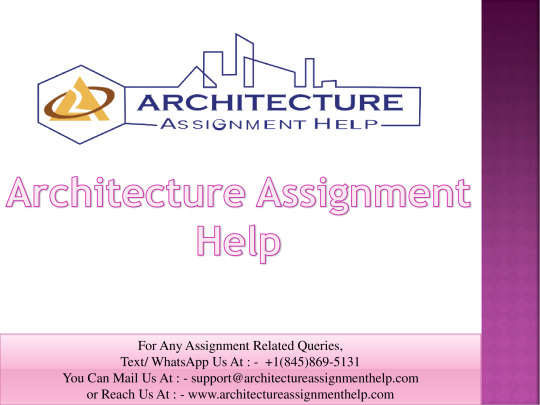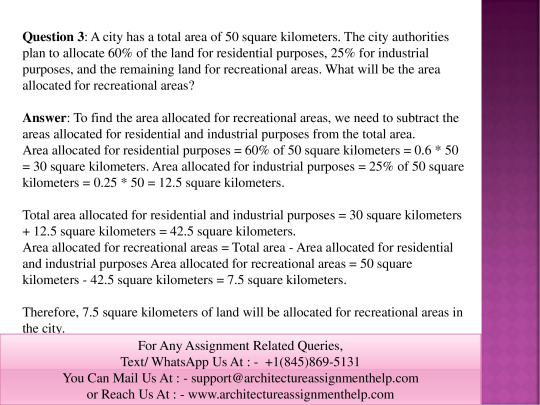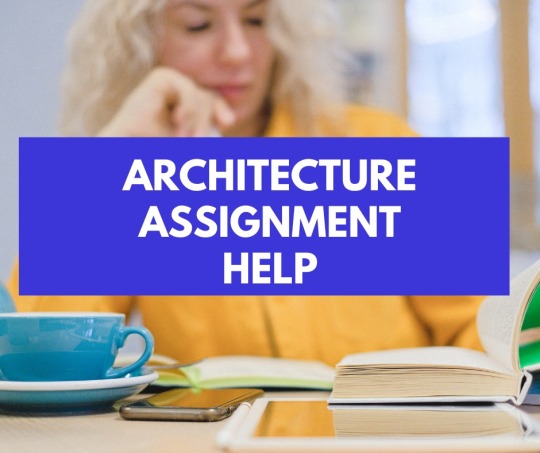#architecture assignment helper
Text
How to Find Architecture Assignment Help in the USA
Are you struggling to complete your architecture assignments in the USA? Don't worry, Our website offers top-notch architecture assignment help specifically to students studying in the United States.
With our expert assistance, you can tackle any architecture assignment with confidence. Our team of experienced assignment professionals comprises architectural experts who possess in-depth knowledge and years of industry experience. They are well-versed in various architectural styles, design principles, and construction techniques.
Simply visit our website and browse through our comprehensive range of services. We offer personalized assistance that aligns with your specific requirements, whether it's drafting architectural plans, conducting research, or providing guidance on design concepts.
Our commitment to excellence ensures that you receive well-researched, plagiarism-free, and high-quality assignments within your specified deadline. We understand the unique challenges faced by architecture students, and our services are designed to alleviate the stress and help you excel academically.
Trust our expertise to enhance your learning experience and achieve outstanding results. Contact us today and take a step towards academic success in the field of architecture.
🌐Website:- www.architectureassignmenthelp.com
📧Email:- [email protected]
📲Call/WhatsApp:- +1(845)869-5131






#architecture assignment help#architecture assignment helper#do my architecture assignment#education#university#tutor#academic#take my architecture exam#assignment help
7 notes
·
View notes
Text

Some students faced problems while projecting their academic assignments. For their best academic support, they can avail of the best services of architecture assignment help and Writing services with the help of professional writers. An expert team of professional writers is always available to assist you. Students have the best educational opportunities and take advantage of them.
#Architecture Assignment Help#Architecture Assignment Helper#Do My Architecture Assignment#education#tutor#academic#university#architecture
2 notes
·
View notes
Text
Unlocking Creativity and Expertise: My Experience with architectureassignmenthelp.com

When I stumbled upon the daunting task of completing my architecture assignments, I felt overwhelmed by the intricate details and the looming deadlines. That's when I discovered the lifesaver - ArchitectureAssignmentHelp.com. Let me share my journey with you, where they not only helped me navigate through the complexities of my assignments but also ignited my creativity in the process.
At first, I was skeptical about seeking external assistance, but the burden of multiple assignments left me with no choice. Upon landing on their website, I was greeted with a user-friendly interface and an array of services tailored to suit my needs. Intrigued by their promises of excellence, I decided to give it a shot. Little did I know that this decision would be a game-changer for me.
The moment I reached out to them, I was greeted by a team of experts who were not only proficient in their field but also genuinely passionate about architecture. They didn't just do my Lumion assignment; they transformed it into a masterpiece. From conceptualizing designs to executing them flawlessly, their attention to detail was commendable. Moreover, they ensured timely delivery without compromising on quality, which eased my stress significantly.
What truly sets ArchitectureAssignmentHelp.com apart is their personalized approach towards each student. They took the time to understand my requirements and preferences, allowing me to collaborate seamlessly with them. Through constant communication and feedback, they ensured that the final output exceeded my expectations. It wasn't just about completing assignments; it was about nurturing my skills and fostering a deeper understanding of architecture.
As I reflect on my experience, I can confidently say that choosing ArchitectureAssignmentHelp.com was one of the best decisions I've made on my academic journey. They not only helped me ace my assignments but also instilled in me a newfound passion for architecture. So, if you ever find yourself struggling with your assignments, don't hesitate to reach out to them. Trust me; they'll do more than just your assignments; they'll unlock your full potential.
#Help with Lumion assignment#do my Lumion assignment#complete my Lumion assignment#Lumion assignment helper#best Lumion assignment help online#architecture assignment help#profe#professional help
0 notes
Text
Advantage of Architecture, Engineering & Construction (AEC) software training
Architecture, Engineering & Construction (AEC) software are developed to help you leverage the cutting-edge design and engineering techniques and solutions to create premium products. Hence, people interested in working in the industry often go for Software training for the AEC. Doing so can provide you an edge over the competitors, and enjoy lucrative career opportunities.
0 notes
Text
The Helper Drone series by JC Jenson

So far in the series, the only two types of drones we’ve known so far are the architectural, yet cowardly and docile worker drones and the sadistic, oil-thirsty disassembly drones. And yet, I feel that there’s a huge possibility that they’re not the only types of drones built by JC Jenson, far from it.
This is part one of an expansion of each of my Murder Drones headcanon from my previous post. I wanted to add a couple of more details about what I talked about before, like their predecessors and other drones built by other companies, and of course, the other types of drones I listed besides workers and disassemblers. I also want to revise my previous theories into headcanon because I had long realized that I was unknowingly making headcanon more than fan theories. From what I’ve learned from having a conversation with a fellow user on the Murder Drones subreddit, theories are only theories if there’s any substantial evidence to support them. Otherwise, it’s just headcanon, what’s generally made up in your head.
The drones’ origins
It’s no secret that humanoid robots were realized long before the 1980′s or 2000′s. My idea for the drones’ predecessors is that they were introduced sometime between the 2030′s or 2050′s (probably during the events of Internecion Cube, that is if Liam is going with the shared universe route). Initially, these machines were first introduced as servants for human households, but overtime, the series had since expanded into a franchise, with various variants built for other environments such as offices, construction areas, warehouses, and hospitals. Obviously, like with smartphones, there were numerous companies jumping ship on the helper robot industry, including JC Jenson. I could go over more details about the helper robots, like public opinion on these machines, their overall treatment from both their producers and consumers, certain “complaints” of products achieving self-awareness and going on either a self-destructive, existential meltdown or a typical robot uprising (which would then force companies to regulate their products’ AI), et cetera. But right now, I want to focus on JC Jenson’s helper robot franchise; I’m going to blandly refer to it as the Helper Drone series.
JC Jenson’s Helper Drone series
JC Jenson has been continuing the Helper Drone franchise for quite a long time, like over 500 years; I have a headcanon that Murder Drones take place sometime between the 2500′s or 2700′s or sometime around the early 3000′s, and I have another headcanon that Murder Drones takes place centuries after C-2 Strain. The Helper Drones were first introduced during the 2060′s as a living home appliance, advertised as friendly robots who help with the chores, caring for your children, and arranging your tasks. As with many other helper robot franchises, the Helper Drone series had since expanded across other workplaces over the decades through newer variants, and throughout the decades or centuries, each variant has been preceded by newer generations, prompting loyal consumers to replace their older models. So far, there had been 1,500–3,000 generations in the franchise.
The Worker Drones are a line of helper robots built to perform endless, grueling manual labor, and as such, they are assigned to blue-collar professions such as construction, mining, manufacturing, sanitation, farming, and landscaping. They’re usually distinguished by their large worker helmet and blue eye optics, and are usually seen any form of worker attire, like a high-visibility vest or a gas mask (let’s assume that drones have weird robot lungs). They’re also distinguished by their various scratches, scars, and dents, as you would expect from drones working in dangerous, thankless jobs and having to endure hazardous conditions like handling hot, boiling steel or withstanding corrosive sulfur. Currently, there’s a “rogue” Worker Drone colony situated on Copper 9 after all the human workers were mysteriously wiped out, and JC Jenson is handling the situation by sending out disassembly squads and having them exterminated as soon as possible.
The Service Drones are a line of helper robots built to provide customer service, such as in restaurants, convenience stores, gas stations, and malls. They’re usually distinguished by their light yellow eye optics to indicate that they’re happy workers, and they would be seen in any form of work attire, like a movie usher’s bow tie, a fast food worker’s novelty hat, or a nice tuxedo/apron combo fit for a waiter. They are also often seen with dents and scratches from dealing with impatient, rowdy customers, and managers would have to get them repaired so that they’d look healthier and happier.
The Office Drones are a line of helper robots built to perform droll, exhausting office work, like documenting and organizing files, providing customer support, and offering financial advice, so they’re basically white-collar robots. There’s also unique variants of office drones called Secretary Drones built to serve as personal assistants for corporate executives, office managers, lawyers, agency directors, and government officials. While Office Drones look similar to a typical helper robot with regular office apparel, secretary drones are about a few inches taller than office drones, have a sleeker, slimmer figure, and are usually seen in clean suits, thus forming some sort of class structure between the Office Drones and Secretary Drones similar with their human counterparts. Both types of drones are identified by their cyan eye optics, and may or may not have been treated poorly by their human coworkers and superiors equally.
The Emergency Drones are a line of helper robots built for emergency services (i.e. police services, fire services, medical services, and rescue services). They’re usually identified by their yellow eye optics and large helmet with a single emergency headlight, and they’re also about as tall and slim as secretary drones. Similar to Worker Drones, they can withstand any form of hazard no human can endure, such as falling debris, roaring flames, noxious gas, and rapid bullet fire (at least the heavily armored units). Emergency Drones are only assigned to rescue victims and transport them to the nearest hospital, but they can still perform medical service and treat their patients with intensive care once they reach their destination.
The Medical Drones are a line of helper robots built to perform medical practices such as physical exams, eye exams, and dental exams. They are distinguished by their pink eye optics and tall, slim chassis, and they’re usually seen in medical attire such as white coats, scrubs, and masks, even though they don’t necessarily breathe. As a basis of Security Drones, Military Drones, and Disassembly Drones, they are equipped with a multi-tool system in place of each of their forearms, allowing them to switch to any tool needed for their procedure, such as a scalpel or a bone saw. Medical Drones are also seen together with Emergency Drones, as the latter transport rescued victims to the nearest hospitals so that the former can begin treating their injuries, but because of that, people often confuse them with each other. There are also a military variant of Medical Drones called Combat Medic Drones that were built to provide medical attention to severely injured soldiers and critically damaged Military Drones.
The Security Drones are a line of security robots that were built to serve as security forces in various institutions, such as banks, malls, transit centers, schools, office buildings, and government buildings, and they also serve as bodyguards for very important figures like government officials and celebrities. They usually appear with a bulky, toned figure, and are often seen in a large helmet (also with a single headlight sometimes) and security attire (usually either a jacket or a bulletproof vest), and they’re seen with either light blue eye optics or red eye optics. These drones are also the first in the franchise to be built with a weapon system in place of each of their forearms, taking inspiration from the medical drones. This allows Security Drones to switch their hands into a ranged weapon such as a laser cannon or a selective-fire machine gun, or with close combat, melee weapons such as a sword, a baton, or a taser. For lighter units that don’t possess a weapon system, they instead wield separate weapons on their own, such as a rifle, a pistol, or a baton. Speaking of batons, there’s also a variant of security drones called Police Drones that are built for police services, detective services, or SWAT services, and ironically, these machines often have a higher performance rate than their human counterparts.
The Military Drones are a line of military robots built as basic advanced infantry for armies, navies, marines, coast guards, air forces, and space forces. While they share the same body figure as Security Drones and Police drones, as well as being equipped the same weapon unit on each of their forearms, they are ten times stronger and sturdier and 20 times deadlier than Police Drones. They’re also seen with green eye optics, and their attire mainly consist of military gear such as a large helmet, a utility belt, and a utility vest. Their weapon system consist of high-grade, state-of-the-art projectile weapons such as high-precision laser rifles, ultra-rapid-fire machine guns, and anti-tank missile launchers. There’s also a variant of Military Drones called Stealth Drones that are built with features such as invisibility or auditory reduction that allow them to sneak along enemy bases and attack enemies by surprise. Variants of Military Drones were considered for extermination of rogue, self-aware drones, but eventually, it would then succeed with a new model of Helper Drones: Disassembly Drones.
The Disassembly Drones are a line of strange, unusual helper robots built to destroy rogue AI. They are built with the same chassis as the Medical Drones, Security Drones, and Military Drones, including the same weapon platform grafted on their forearms. Other than that, they are also seen in silver wigs (grafted or otherwise) and sometimes a clean, dark uniform complete with a yellow armband. Compared to Security Drones and Military Drones, their weapon system allows them to change into any dangerous weapon they see fit, such as a pair of claws, a missile launcher, a chainsaw, or an EMP wave generator, making them a sentient arsenal. Other than using a nanite-based regeneration system like with other models, they are equipped with a nanite-assisted alloy that allows them to grow back a missing body part like a head or an arm. Some models also seem to be vampire-like, as they need to drink oil in order to not overheat, or that they need to stay away from the sunlight in order to avoid activating a solar-powered fail-safe, but they couldn’t transform other drones into new Disassembly Drones by biting them, of course. As opposed to many other drones, Disassembly Drones seem to have personalities of their own. Many of them retain a stoic, obedient personality (i.e. Serial Designation J), while some of them either have an apathetic, aloof personality or a sadistic, wild personality (i.e. Serial Designation V). I have a headcanon that there are about only a few Disassembly Drone units built (like 25), while the rest of the units (about 225 of them) were actually recycled from other drones of different kinds due to JC Jenson not wishing to waste more of their profits, hence their built-in personalities.
The Goliath Drones are a line of large helper robots that were built for extreme heavy-duty labor. They are incredibly tall, bulky, and strong, weighing in around five to eight tons and towering in about 20 or 30 feet, and many of them are built with large multi-tool system on their forearms, allowing them to use any massive tool for their assignment, like a drill, a hydraulic jackhammer, or a huge shovel. These behemoths are usually assigned to heavy-duty assignments at mines, factories, deep waters, landfills, and sulfur pits, and much like Worker Drones, they can withstand any form of punishment such as swimming across molten steel, shrugging of corrosive sulfur, or traversing through heavy pressure underwater. Because of their incredible strength and durability, there are variants of Goliath Drones built for military services called Eradicator Drones, and they are equipped with a heavy weapon system that allows them to switch to any form of powerful artillery such as an autocannon or a howitzer. There is currently development of a disassembly variant of Goliath Drones, as part of Project Purge, for complete eradication of groups of rogue drones.
So, that’s what I have for this headcanon, the numerous types of drones built by JC Jenson. Hopefully, I could expand the other headcanon very soon.
16 notes
·
View notes
Text

Receive Premium assistance from our Architecture experts within specified timeline. Our Architecture Assignment Helpers provide complete assistance in all topics and courses.
0 notes
Text
BrainBox AI Introduces the ARIA Virtual Assistant

The first virtual building helper, known as ARIA (Artificial Responsive Intelligent helper), was introduced today by building technology pioneer BrainBox AI. ARIA, which integrates smoothly into daily building management procedures, is meant to improve building efficiency. It is powered by the most recent generative AI technology with Amazon Bedrock. Like Iron Man and Jarvis, ARIA is a unique combination of technology and creativity that makes it the go-to partner for facilities managers. Specifically designed for usage in commercial and retail settings, ARIA has the predictive capacity to avoid issues with operations while keeping an eye on a building’s blind spots, hence revolutionising conventional facilities management.
Using the cutting-edge autonomous AI technology from BrainBox AI as its internal compass, ARIA offers a comprehensive 360-degree view of a building’s data, focusing on its systems and components to generate recommendations for strategic decision-making that are not only accurate but also comprehensively informed. A two-way exchange is fundamental to the architecture of ARIA. In addition to giving it instructions to do certain duties, building operators and facility managers can also rely on the virtual assistant to make decisions and provide direct advice on how to operate their building in the most effective and efficient way going forward.
Customers may easily transition their conversations from desktop to mobile without missing a beat by using ARIA to “call” others via text or voice. The round-the-clock generative AI engine of ARIA assists customers in organising and optimising their buildings. Building management becomes proactive instead of reactive with this master feature, which also raises the building’s value and directly supports an organization’s sustainability initiatives.
“Their customers can reach their specific objectives for decarbonisation, energy consumption, and operational efficiency with the aid of ARIA’s intelligence and intuition, which utilises AI in really novel ways. Cofounder and chief technology officer of BrainBox AI Jean-Simon Venne remarked, “Building teams can focus on more value-driven tasks by assigning mundane operational tasks and repetitive analytics to ARIA.””Generative AI has shown its unlimited potential in every industry in two years. It is a valuable tool to any company looking to remain ahead of the curve in efficiency and innovation, as shown by its quick acceptance by the market and fast expansion.
The totally autonomous feature of the organisation is based on Amazon Bedrock and is encircled by a special blend of AWS Lambda, AWS Fargate, and Amazon Athena services. A wide range of tools enabling BrainBox AI to create generative AI applications with security, privacy, and responsible AI are provided by Amazon Bedrock, a fully managed service that provides a selection of top-performing foundation models from top AI businesses and Amazon via a single API.
BrainBox AI can use machine learning and artificial intelligence (AI) to accelerate innovation and create readily scalable AI-powered products thanks to Amazon Web Services (AWS). BrainBox AI made an official announcement in January announcing its entry into the AWS Partner Network, an international network of AWS partners that pool resources, knowledge, and programmes to develop, promote, and sell client services.
According to Howard Wright, vice president and global head of startups at AWS, “Amazon Bedrock was designed to help companies build transformative generative AI solutions and get to market faster.” “They are thrilled to see ARIA realized a groundbreaking solution that will transform building operations and empower facility managers worldwide to improve energy consumption and decrease emissions. emissions even more than they have been able to do with BrainBox AI’s current solution.”
As it continues to set the standard for built environment solutions, ARIA is BrainBox AI’s lasting imprint on the generative AI field. By lowering HVAC energy expenditures by up to 25% and greenhouse gas emissions by up to 40%, ARIA significantly improves building operations management when combined with BrainBox AI’s core AI for HVAC technology. This major invention that significantly advances the company’s goal of using AI to help preserve the world excites it.
Regarding BrainBox AI
BrainBox AI was created in 2017 to address the built environment’s biggest issues carbon emissions and energy usage. BrainBox AI, a decarbonisation pioneer, leverages AI in its innovative HVAC technology to make buildings smarter, greener, and more efficient. BrainBox AI provides real estate customers in a variety of industries with enhanced services, including office buildings, hotels, grocery shops, airports, and more, via strategic worldwide collaborations.
Its workforce of over 170 individuals, with its headquarters located in Montreal, Canada, a worldwide centre for AI, brings talent from various sectors of the business world together with the shared goal of healing the planet. Research partners of BrainBox AI include the Institute for Data Valorization (IVADO), MILA Quebec AI Institute, and academic organisations like McGill University.
FAQS
What are the benefits of ARIA?
Improved Efficiency: ARIA can help facility managers optimise building operations, reducing energy costs by 25%.
ARIA can reduce greenhouse gas emissions by 40% by optimising energy use.
Proactive Management: ARIA analyses data and suggests solutions before issues arise, improving building management.
How does ARIA work?
Generative AI: ARIA uses generative AI to get new data insights to improve building operations.
Data Analysis: ARIA analyses building system and component data to optimise energy usage.
Communication: ARIA can advise and answer facility managers.
Read more on Govindhtech.com
0 notes
Text
Take the Burden off Your Shoulders with Our Effective Computer Architecture Assignment Help

Computer Architecture is all about having a set of rules and procedures that define the arrangement of functions, the functionality, and the implementation of computer-related systems. As per our Computer Architecture assignment assistance experts, it also includes the design of instruction set architecture, microarchitecture design, logic design and implementation. It contains three significant subcategories, which are instructions set architecture and microarchitecture as well as system development. With a deep understanding of the subject, Our writers have dealt with every one of the advanced subjects with aplomb and helped many students attain excellent scores.
Here, we have our highly efficient team of assignment writers to offer the best computer-related assignment help to students' benefit. We have our expert team who have been writing assignments for years. The quality of our work is unquestionable and highly regarded by students. We've been providing prompt assignment writing services that are of the highest quality. Contact us at the earliest date to be ready with your assignment. Additionally, there are other services like editing and last-minute assignment assistance for students in need of help immediately.
Get the most effective computer-based homework help for architecture on the internet with us. We offer reliable help to improve your knowledge and increase your marks. Contact us today to take the burden of computer-related assignments!
They trust us to the last drop and contact us for help with writing assignments on topics in computer design, regardless of how difficult they might be. Similar to other companies, we don't make any false promises. If we've committed that you'll receive top-quality work for a reasonable price, We won't change even a centimetre.
We offer Computer Architecture Assignment Helper at a reasonable price so that students don't have to cut back on their savings to finish their work in a timely manner. You can get both high-quality and faster results by utilizing a Computer Architecture Assignment Expert.
0 notes
Text
Expert Architecture Assignment Help for Stellar Academic Success
Are complex architecture assignments giving you sleepless nights? At Architecture Assignment Help, we offer top-notch assistance tailored to your academic needs. Our dedicated team of experienced architects and writers is here to provide comprehensive support for all your architecture assignment challenges.

Why Choose Us?
Expert Team: Our team consists of skilled architects and proficient writers with in-depth knowledge of architecture concepts and academic requirements.
Customized Solutions: We understand that each assignment is unique. That's why we craft custom solutions that align with your specific guidelines and instructions.
Timely Delivery: Tight deadlines? No problem! We are committed to delivering your assignments on time, ensuring you never miss a submission.
Quality Assurance: Our stringent quality checks guarantee error-free, well-researched, and properly referenced assignments that meet the highest academic standards.
24/7 Support: Have a question or need assistance? Our customer support team is available round the clock to address your queries.
Say goodbye to assignment stress and hello to academic excellence. Let us be your partner in achieving remarkable grades and a deeper understanding of architectural concepts. Get in touch with us for top-quality architecture assignment help today!
#architecture assignment help#architecture assignment helper#do my architecture assignment#take my architecture exam#assignment help#education#university#tutor#academic#online architecture assignment help
2 notes
·
View notes
Text
Mastering Architectural Sketching: A Guide to Excelling in Your Assignments
Welcome back, architecture enthusiasts and aspiring designers! Today, we're delving into the intricate world of architectural sketching. As we all know, mastering the art of sketching is not just about putting pen to paper; it's about capturing the essence of design, understanding spatial relationships, and communicating ideas effectively. If you're seeking help with your architectural sketching assignment, you've come to the right place.
Let's kick things off with a fundamental question:
Question 1:
Explain the importance of sketching in the architectural design process and how it aids in the development of ideas.
Answer:
Architectural sketching is the cornerstone of the design process, serving as a vital tool for architects to explore, refine, and communicate their ideas. At its core, sketching allows architects to visually brainstorm concepts, translating abstract thoughts into tangible forms. Unlike digital tools, sketching offers a sense of immediacy and freedom, enabling designers to experiment without constraints.
In the initial stages of a project, sketching serves as a means of exploration, allowing architects to quickly generate multiple design options. Through rough sketches and thumbnail sketches, designers can explore various spatial arrangements, proportions, and conceptual frameworks. This iterative process encourages creative thinking and facilitates the discovery of innovative solutions.
Moreover, sketching plays a crucial role in communication within the design team and with clients. Sketches serve as a universal language, bridging the gap between ideas and reality. By sketching out their visions, architects can effectively convey design concepts, facilitating discussions and collaborations. Additionally, sketches provide clients with a glimpse into the designer's thought process, fostering transparency and trust.
Beyond its practical applications, sketching also nurtures essential skills such as observation, visualization, and hand-eye coordination. Through consistent practice, architects develop a keen eye for detail and a deep understanding of spatial relationships. This mastery of sketching techniques empowers designers to express their creativity with confidence, resulting in more refined and cohesive designs.
Now, let's tackle another challenging question:
Question 2:
Discuss the role of perspective drawing in architectural sketching and provide tips for mastering this technique.
Answer:
Perspective drawing is a fundamental aspect of architectural sketching, allowing designers to create realistic depictions of three-dimensional spaces on a two-dimensional surface. By understanding and harnessing the principles of perspective, architects can imbue their sketches with depth, scale, and spatial clarity.
Central to perspective drawing is the concept of vanishing points, which establish the convergence of parallel lines in space. In one-point perspective, all lines converge to a single vanishing point on the horizon, creating the illusion of depth along a single axis. This technique is often used for frontal views or elevations of buildings. In contrast, two-point perspective utilizes two vanishing points to depict objects from an oblique angle, adding complexity and dynamism to the composition. Finally, three-point perspective incorporates a third vanishing point above or below the horizon, allowing for extreme foreshortening and dramatic viewpoints.
To master perspective drawing, architects must grasp the principles of foreshortening, proportion, and scale. Start by establishing the horizon line and vanishing points, ensuring consistency and accuracy throughout the sketch. Pay close attention to the placement of objects relative to the viewer's perspective, adjusting their proportions accordingly. Experiment with different vantage points and compositions to convey depth and dimensionality effectively.
Additionally, practicing freehand sketching is essential for honing one's perspective drawing skills. Embrace the imperfections of hand-drawn sketches, as they often add character and authenticity to the final result. Remember to observe the world around you and study architectural precedents to gain insights into spatial relationships and compositional techniques.
In conclusion, mastering architectural sketching requires dedication, practice, and a deep understanding of design principles. Whether you're a novice designer or a seasoned architect, embracing the art of sketching can unlock new avenues of creativity and innovation. If you ever find yourself in need of assistance with your architectural sketching assignments, remember that help is just a click away. Happy sketching!

#Help with architectural sketching assignment#do my architectural sketching assignment#complete my architectural sketching assignment#architectural sketching assignment helper#architectural sketching assignment help#architecture assignment help#education#architecture assignment helper
0 notes
Text
Advantage of Architecture, Engineering & Construction (AEC) software training
Architecture, Engineering & Construction (AEC) software are developed to help you leverage the cutting-edge design and engineering techniques and solutions to create premium products. Hence, people interested in working in the industry often go for Software training for the AEC. Doing so can provide you an edge over the competitors, and enjoy lucrative career opportunities.
AEC software training would enable designers, engineers, and contractors to get acquainted with a range of designers, engineers, and contractors with a set of BIM and CAD tools that can support projects from early-stage design through to construction. Top AEC software Training Center offers a number of programs. By pursuing them, you shall be able to:
Create high-performing and high-quality building and infrastructure designs with detailed, conceptual design tools
Optimize projects with generative design, integrated analysis, as well as visualization and simulation tools
Improve predictability in the field with the use of tools that maximize constructability and project coordination
Professional certifications and software training are important for developing, honing and validating skills crucial to the industry. No matter whether a program is focused on enabling professionals to excel in specialized engineering domains, stay abreast of sustainable design principles or master the latest project management methodologies, it would allow them to contribute to projects with heightened competence.
In sectors like architecture, engineering and construction, innovation and excellence are paramount. Hence, companies based in the AEC sector require trained and qualified candidates who can provide them a competitive edge. Clients and stakeholders of such companies may seek assurance in the form of trained professionals who can not only bring theoretical knowledge to the table but also have a practical understanding of industry best practices. AEC software training programs can improve your employ ability, and make you a candidate discerning companies can depend on. The right software training programs would allow you to stay remains at the forefront of advancements, and assure the employers that you can deliver cutting-edge and high-quality work.
Details of organizations that can Architecture assignment helper tutor and more can be found on the web.
0 notes
Text
Africa’s True Allies Are in Kyiv, not Moscow
The African continent is becoming a priority in Ukrainian foreign policy. Ukraine is one of the guarantors of food security in this region of dynamic development, and our diplomatic efforts are already demonstrating results in changing the paradigm of African politics. The position of African countries during the voting in the UN General Assembly eloquently confirms this. However, Africa remains a hotbed of geopolitical confrontation.
Russian imperialists want to impose their will on the countries of Africa and take advantage of them in their interests. The Russia-Africa Summit, scheduled for July 27−28, should be seen as a preparation for the geopolitical gripe into which the Russians want to drive the peoples of Africa.
In fact, this forum aims to form the impression of a breakthrough in the international isolation of Russia, creating the illusion of support for the Kremlin by the so-called “world majority,” an important part of which is the African population of the planet. And while this participation in someone else’s performance is still relatively voluntary, African leaders should think about the role assigned to them.
In reality, it is not the solidarity with Russian follies that is in the interests of most people and countries of the world, but the preservation of the effectiveness of international law and security architecture based on UN documents and institutions.
Clear principles and rules protect primarily those who cannot or do not plan to defend themselves with nuclear weapons and their murderous equivalents. Conversely, for the aggressor, which is today’s Russia, international law stands in the way. Therefore, Moscow seeks not only to destroy Ukraine, but also to discredit the rules that prohibit it from doing so.
The Kremlin’s global goal is to destroy the international order and, instead of the force of law, to impose the rule of force in relations between countries. This is something that threatens African countries no less than Ukraine.
Russia’s struggle against the current international security architecture threatens not only the return to times of the war of all against all, but also the disruption of sustainable development programmes, climate change control, and systemic international support for vulnerable societies in the fight against hunger and poverty.
Russia withdrew from the grain deal, and this threatens to increase prices for agricultural products and the emergence of an acute shortage of food available to African countries. Due to the Russian counteraction, in particular, the shelling of the port infrastructure and granaries of Ukraine, the charitable initiative of the President of Ukraine Grain from Ukraine, funded by the United Nations, is also at risk of disruption.
Russia invariably covers its struggle against the West (and in fact against the principles of civilized coexistence in the world) with anti-colonial rhetoric inherited from the Soviet Union.
READ ALSO: Russian Narratives in the Global South: Main Trends
Probably, Moscow hopes for widespread blindness in African countries, which Russia has chosen as its “wards.” After all, in the modern world, it is impossible to conceal the glaring facts of the Kremlin’s enslavement of dozens of indigenous peoples of the Russian Federation — depriving them of their languages, rights, and prospects.
Meanwhile, Russia’s colonial appetites are not at all limited to its own (the world’s largest) territory, as well as neighbouring Ukraine. The Russian tsars were late to the redistribution of the African continent by European colonizers in the 19th century. Now, Putin’s regime seeks to make up for what was lost and seize the natural resources of Africa.
Russia uses mercenaries of Wagner PMC to interfere in the internal affairs of the continent’s states, implementing operations to overthrow legitimate governments (Mali, Burkina Faso). Instead of guarding, Russian “helpers” provoke political instability and only exacerbate old problems in African countries. The activities of Russian mercenaries fuel the flames of separatism and religious extremism.
What political model can Russia export to Africa, if it is a corrupt, aggressive dictatorship that keeps its population in submission through repression and zombifying propaganda? Moscow can offer nothing but corruption, lies, terror, and wars to Africa.
The Kremlin considers the countries of “Black Africa” underdeveloped, naturally prone to atrocities and barbarism. Unlike the West, Russia will not, as they say, “impose democracy.” Instead, Russia came to corrupt its elites and teach them to keep their peoples in lawlessness.
By methods of blackmail and bribery, Moscow is trying to get the votes of African countries in the UN. These are votes against Ukraine and against international law. However, so far, Russian diplomacy has not won the coveted victories.
On the contrary, after two tours of African countries by Foreign Minister Dmytro Kuleba and the launch of a new strategy for Ukraine’s interaction with Africa, Kyiv’s position in the General Assembly is becoming stronger. African countries repeatedly support resolutions aimed at restoring international law. These votes meet primarily the national interests of the African countries themselves.
Lavrov can participate in colourful African rituals as much as he wants, but that doesn’t change the fact that he represents a country with deep-rooted racism, xenophobia, and chauvinism. The true attitude of Russia towards African leaders was evidenced when it fired missiles at Kyiv during the stay of a peacekeeping delegation from African countries on June 23 this year.
Independent Ukraine is the result of a long anti-colonial struggle, whose milestones sometimes differed little from the events of African decolonization. Ukrainians understand perfectly the national feelings of the peoples of Africa, who do not tolerate arrogance and hypocrisy. We are natural allies in upholding the sovereignty and principles of international law that guarantee freedom and territorial integrity to all.
READ ALSO: Experts and Diaspora Leaders Discuss Ways to Enhance Ukraine’s Relations with the Global South
Indeed, the growth of Ukrainian interest in Africa is dictated primarily by the challenges of Russian aggression. But the mutual interest of African countries in Ukraine can bring them practical benefits. Ukraine is extremely effective in finding allies and support to repel aggression. This experience is invaluable and worthy of following by those who find themselves in a similar situation.
The common interest in ensuring food security has already been discussed. But there can be many more areas of mutually beneficial cooperation: education, technology, construction, energy, etc.
Nowadays, Ukraine is discovering Africa, but this is not the first time we are here. After all, many positive examples of cooperation with the USSR (the Putin regime parasitizes on the nostalgia for it) are in fact precisely the Ukrainian contribution and merit. It’s just that Ukraine itself did not get rid of Moscow’s colonial domination back then, and therefore its people, resources, and work for the benefit of international friendship were held under the guise of “Soviet” (and therefore “Russian”). It is time for Africa to rediscover Ukraine as well.
The post Africa’s True Allies Are in Kyiv, not Moscow appeared first on Centre for strategic communication.
0 notes
Photo

Receive Premium assistance from our Architecture experts within a specified timeline. Our Architecture Assignment Helpers provide complete assistance in all topics and courses.
0 notes